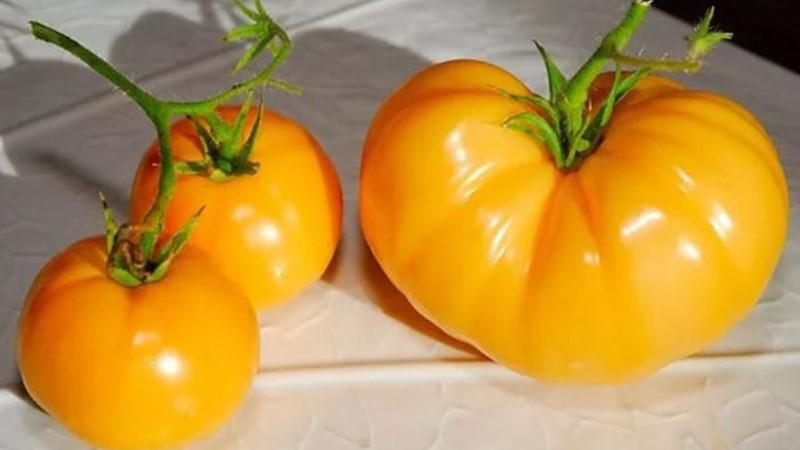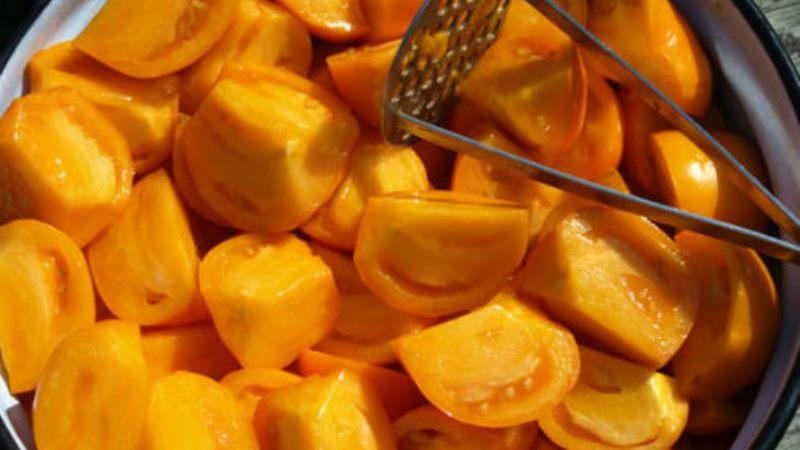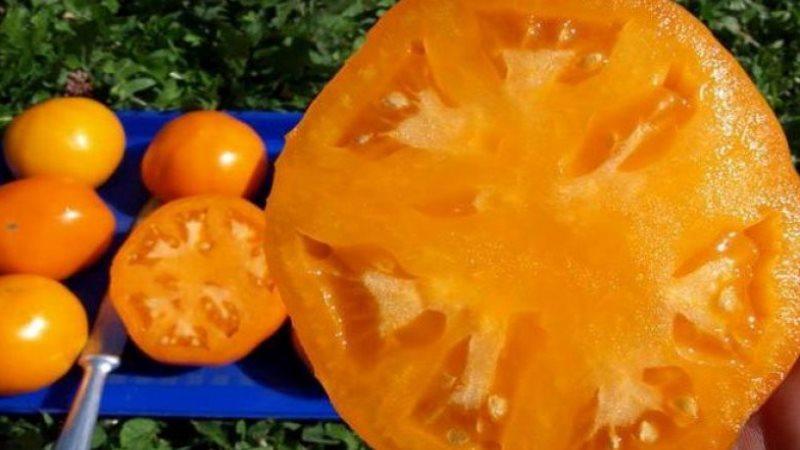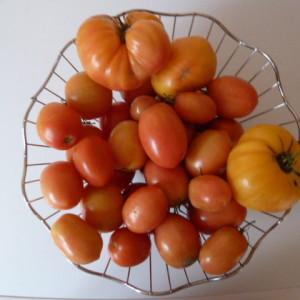How to grow "Persimmon" tomato on your plot - tricks and tips from experienced gardeners
The Persimmon tomato variety got its name due to its external resemblance to the fruit of the same name. Its fruits are similar to "sun balls", which not only delight with their appearance, but also have an excellent dessert taste and aroma.
This young grade gained popularity and love among gardeners. Read on for a detailed overview of its varietal characteristics.
The content of the article
Characteristics and description of the variety
Persimmon tomatoes are mid-season varieties. The first fruits ripen in 110-115 days from the moment of seed germination. The variety is determinant, the plant grows from 70 to 100 centimeters. Strong bush with abundant bright green foliage, powerful stem.
Important! When buying seeds, please note that different growers have plant heights ranging from 60-70 cm to 120-150 cm.
Distinctive features
Distinctive features of the Persimmon variety:
- bright honey-orange color of ripe tomatoes;
- the fruits are sweet, fleshy, the pulp is juicy;
- the first tomatoes are very large.

Description of fruits and yield
Its bright golden-orange color is due to its high beta-carotene content. Due to the low content of organic acids, the tomato has a sweet taste. The fruit is tender and fleshy due to the multi-chamber structure of the pulp. On a cut, there are from 4 to 8 seed chambers.
The first fruits grow large. Cases of fruits reaching a mass of more than 500 g have been recorded. On subsequent clusters, the weight of the tomatoes evens out and already averages 150-250 g.
The persimmon variety has a high degree of fruit set. The brushes are of a simple structure, forming three to five tomatoes.
How to grow seedlings
It is extremely important to grow healthy and strong seedlings, since the future health and productivity of the plant depends on it. Consider the features of growing at the initial stage.
Seed preparation
To make the seeds germinate faster, they are soaked. Before planting, fill the seeds with warm water and leave for 1-2 hours. Seeds that float are not suitable for planting. The rest can be safely used.
Advice... It is useful to add a little potassium permanganate to the water when soaking. This will disinfect the seeds and prevent future diseases from developing.
Promotes resilience to various diseases soaking in growth stimulants (for example, "Baikal", "Epin Extra", "Zircon").
Capacity and soil
Tomatoes prefer slightly acidic, closer to neutral soil 5-6 PH.
For planting, use ready-made universal substrates or prepare the mixture on their own: mix sand, peat and earth in equal proportions. The mixture prepared independently for disinfection is calcined in the oven and spilled with a solution of potassium permanganate.
In the process of growing seedlings, you will need two types of containers:
- a low container or box for planting seeds for germination. For these purposes, ordinary food containers or a wooden box covered with plastic are suitable. Remember to provide drainage holes;
- individual containers for growing plants after picking.In hardware stores, there is a large assortment of ready-made growing containers. Or use food grade plastic cups and other containers that are convenient for you.
Sowing
Sowing seeds is carried out 50-60 days before the intended planting of the plant in the ground or greenhouse. The seeds are placed in moistened ground to a depth of 1-1.5 cm. To reduce moisture evaporation, the container is covered with a film.
After the first seeds germinate, the film is removed. The optimum temperature for keeping sprouts varies in the range of 20-24 degrees.

Growing and care
After opening 1-2 leaves on the sprouts (after about 15-20 days), the seedlings dive. The seedling is buried in the ground up to the cotyledon leaves. A few days after transplanting, when the plant slightly adapts to new conditions, the night temperature is gradually reduced to +18 degrees.
Water the seedlings in moderation, in the morning, with lukewarm water. An excess of moisture is dangerous for the plant by the development of diseases.
Once every 2-3 weeks, top dressing is applied based on potassium and phosphorus.
How to grow tomatoes
At the age of 60-65 days, the seedlings are ready to "move" to a permanent place of growth. By this time, 5-7 leaves will already open on the plants.
Landing
A few days before planting, the earth is spilled with a strong solution of potassium permanganate. This is required to disinfect the soil from potential bacteria and pests. No more than 3-4 plants are planted on one square meter. The optimal distance between the bushes is 45-60 cm.
For planting seedlings, use the trench or pit method.
Trench method
A trench is dug along the bed, in which the plants are laid lying down. Then the trench is covered with earth and shed well. With this planting, a significant deepening of the stem occurs, due to which the plant forms a large number of additional roots.
On a note... Do not worry that the top of the plant is tilted to the side with this planting. As soon as the tomato begins to grow, the direction of the crown will fully straighten.
Pit method
With the pit planting method, an individual hole is prepared for each plant. A handful of humus or humus is added to the bottom of the hole and filled with 1-2 liters of water. After all the water has been absorbed, a plant is placed in the planting hole, covered with earth and compacted well.
No watering is required for 7-10 days after planting. The moisture introduced at the time of planting will be enough for the plant. During this time, the root system will get stronger and go deep into the soil.
Plant care
A yellow Persimmon tomato requires standard care procedures: watering, loosening and feeding. Let us dwell in more detail at each stage.
Watering
All nightshades, and the Persimmon variety is no exception, love the sun and dry air. Waterlogging of the roots is unacceptable, as this often leads to the development of putrefactive and fungal infections.
To water tomatoes are preferably in the morning, then during the day the soil will have time to dry out a little, and the roots will absorb water. As a result, the roots will not be overcooled at night, and the overall plant immunity will be higher.
Abundant watering 1-2 times a week will be sufficient. If a drip irrigation system is connected to the tomatoes, then daily watering in small portions is adjusted.
Weeding and loosening
Timely weeding and loosening of the soil improves oxygen access to the plant roots. Removing weeds helps control pests.
Do not allow a hard crust to form on the ground as it will scratch the stem. Pathogens enter the plant through damage.
Keeping the surface layer of the soil around the tomato clean and tidy will guarantee the health of the plant and, as a result, a good harvest in the future.
Bush shaping, pinching and garter
Since the variety is determinant, it is optimal to form a bush into two or three stems to increase productivity. For this, 1-2 lower stepsons are left on the main stem.The rest of the stepsons are removed.
Due to the large fruits and high stem, the bush requires a garter. Growers use several methods to support long branches. The stems are tied up:
- to an individual support installed at a distance of 10 cm from the trunk;
- to the trellis installed along the tomato garden;
- to the guides of the greenhouse.
The branches are tied up both with special clips and with ordinary nylon or jute twine. It is important to leave a small space of 2-3 cm around the stem so that the rope does not pinch the branches as it grows.

Top dressing
A hybrid with large tomatoes especially needs regular feeding with mineral and organic fertilizers. The plant needs nitrogen, potassium, phosphorus and calcium.
Humus, vermicompost or peat compost are considered the best for spring application. Excessive addition of fresh manure and nitrogen fertilizers will promote a rapid build-up of green mass and inhibit fruiting.
Depending on the growth phase, the tomato requires different doses of minerals. For 10 liters of water add:
| Growth phase | Substance, gram | ||
| Ammonium nitrate | Superphosphate | Potassium chloride | |
| 7-14 days after planting in the ground | 15-20 | 45-50 | 5-10 |
| Until the formation of three clusters of fruits | 25-30 | 70-80 | 20-25 |
| The entire period of fruiting | 30-40 | 30-40 | 25-30 |
If the green mass grows too intensively, the amount of ammonium nitrate is reduced. In order for the plant to begin bearing fruit faster, the dosage of potassium and phosphorus (superphosphate) is increased.
Important! In order not to burn the roots, the plant must be watered immediately after top dressing.
Features of cultivation and possible difficulties
The manufacturer has not declared an increased resistance to diseases, however, correct agricultural technology will allow you to grow a healthy plant and get a good harvest.
If the plant is strong, feel free to leave the 2 lower stepsons; if it develops poorly, then no more than one.
Diseases and pests
Most often, plants begin to hurt when mistakes are made in agricultural technology.
The main reasons for the development of diseases:
- thickening of landings;
- waterlogging of an earthen coma;
- lack of oxygen at the roots;
- air humidity above 60%;
- lack of minerals.
For the treatment of bacterial infections, fungicides of chemical or biological origin are used. Chemical fungicides include: "Bordeaux liquid", "Ridomil"; to biological: "Fitosporin", "Ecosil".
To prevent insect attacks, plants are sprayed with chamomile, celandine or garlic tincture. Aphids are washed off with soapy water.
For the prevention of late blight, starting from August, it is advisable to spray tomatoes with phytosporin or another fungicide of your choice once a week.
The nuances of growing in open ground and in a greenhouse
In the open field, the plant grows up to 70 cm.When grown in typical shelters, the stems develop better, and the length is 90-100 cm.The seedlings are planted in the greenhouse in mid-May, and in open ground - in early June, when the probability of night frosts disappears.
Harvesting and application of the crop
In late July - early August, the first fruits begin to ripen. Then the bush bears fruit stably until the onset of cold weather. The yield of the variety is 5.8 kg of tomatoes per one square meter of planting.
Persimmon tomatoes - for salad purposes. The most successful taste of the variety will be revealed in fresh salads, cold snacks and juices.
Tomatoes are not suitable for long-term storage.
Advantages and disadvantages of the variety
The advantages of the variety:
- bright golden honey color;
- juicy pulp with a multi-chamber structure;
- sweet taste;
- high productivity.
Disadvantages of the variety:
- average resistance to disease;
- uneven fruit size (first fruits are larger than subsequent ones);
- short shelf life.
Farmers reviews
A study of reviews and photos of gardeners who grew persimmon tomato confirm compliance with the description of the variety. All the reviews noted the high taste of tomatoes.Among the disadvantages of the variety, it is noted that ripe fruits are poorly stored and do not withstand long transportation.
Conclusion
Persimmon tomatoes hit the market only in 2009, but despite their youth, the variety has already won the respect and love of gardeners. The main value of the variety lies in its excellent taste. It more than pays for all the difficulties of growing a tomato, and the plant will thank you with a generous harvest for good care.